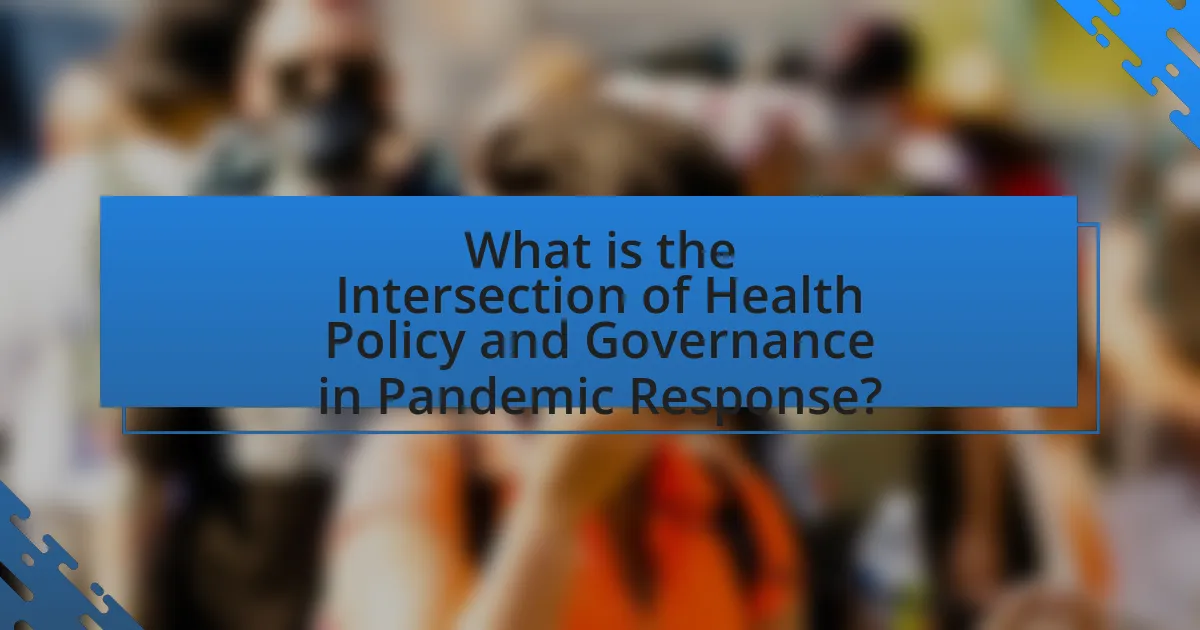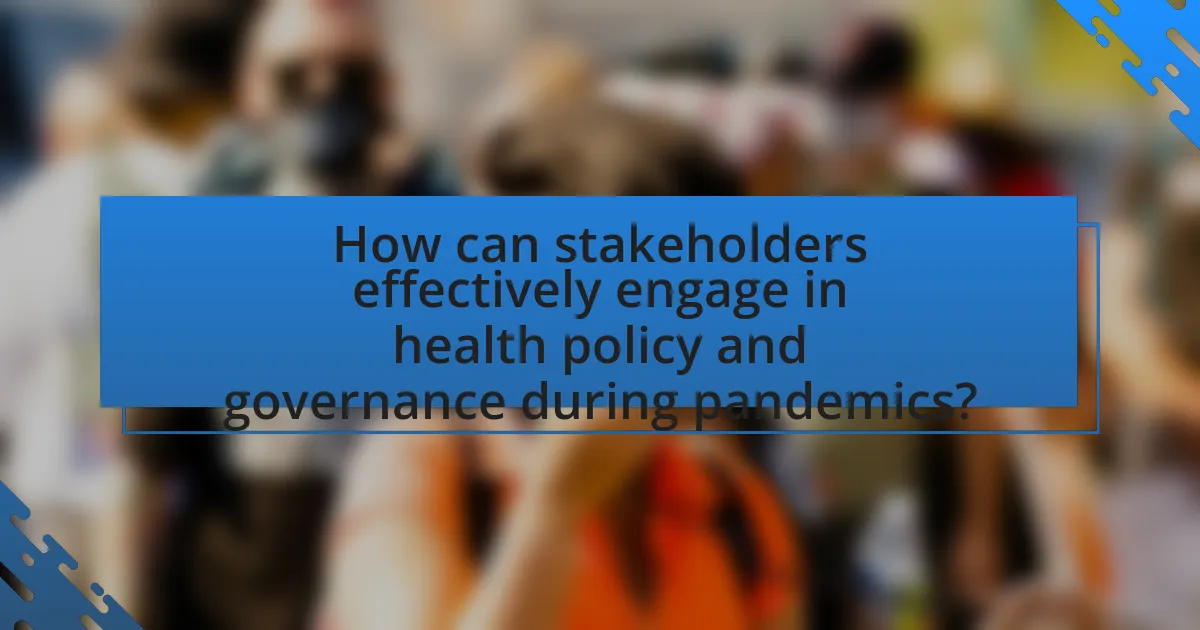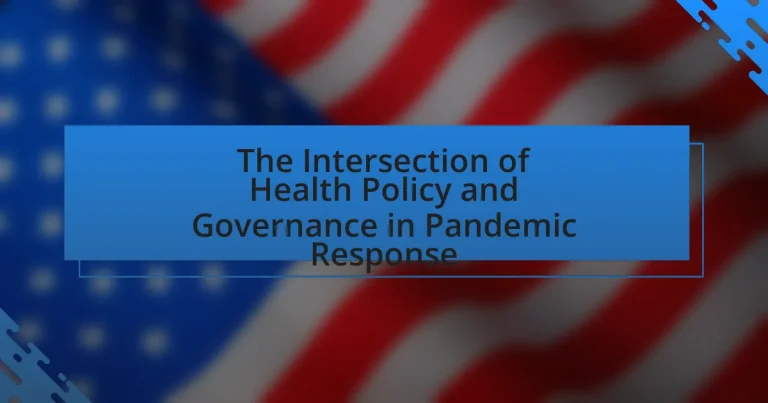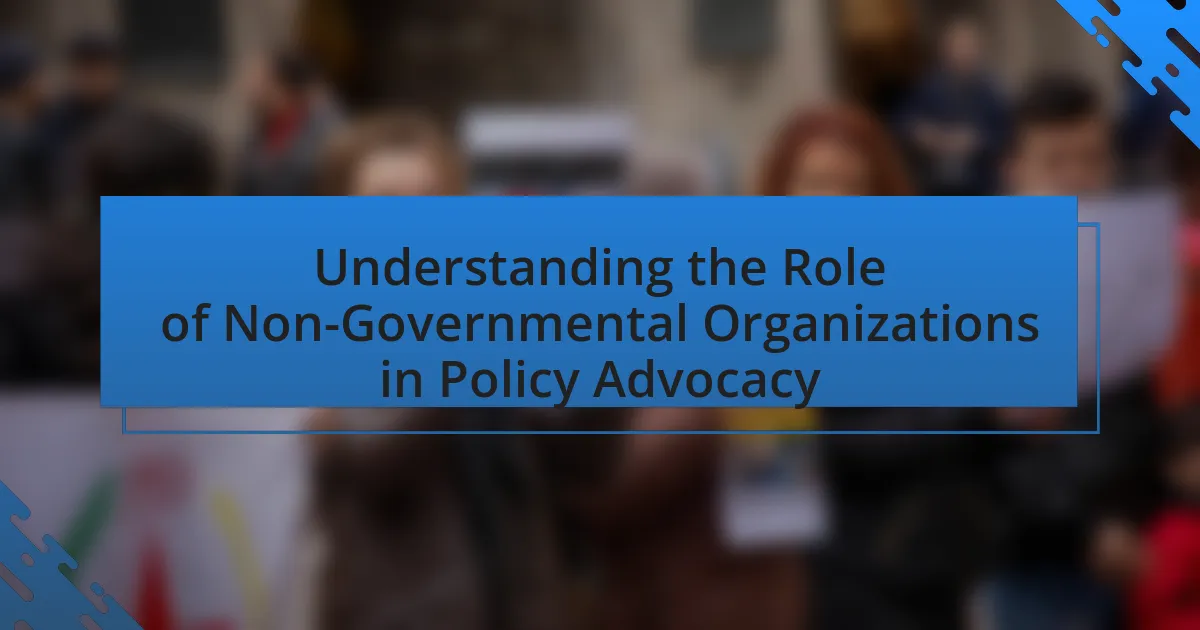The article examines the intersection of health policy and governance in pandemic response, highlighting the collaboration between governmental structures and health regulations essential for managing public health crises. It discusses how effective governance influences the implementation of health policies, the key components of health policy during pandemics, and the role of government agencies in shaping these policies. The article also addresses challenges such as coordination failures and public trust deficits, while emphasizing the importance of international cooperation and data sharing for improved health outcomes. Additionally, it outlines best practices for stakeholder engagement and communication strategies that enhance the effectiveness of health governance during pandemics.

What is the Intersection of Health Policy and Governance in Pandemic Response?
The intersection of health policy and governance in pandemic response involves the collaboration between governmental structures and health regulations to effectively manage public health crises. This relationship is crucial as it determines how resources are allocated, how information is disseminated, and how interventions are implemented during a pandemic. For instance, the World Health Organization’s International Health Regulations provide a framework for countries to report and respond to health emergencies, emphasizing the need for strong governance to enforce health policies. Effective governance ensures that health policies are not only created but also executed efficiently, as seen in countries that successfully controlled outbreaks through coordinated efforts between health authorities and government agencies.
How do health policy and governance interact during a pandemic?
Health policy and governance interact during a pandemic by establishing frameworks for decision-making, resource allocation, and public health interventions. Health policies provide the guidelines and regulations necessary for managing health crises, while governance structures ensure that these policies are implemented effectively and transparently. For instance, during the COVID-19 pandemic, governments worldwide enacted policies such as lockdowns, mask mandates, and vaccination campaigns, which were guided by public health data and expert recommendations. The World Health Organization emphasized the importance of strong governance in coordinating responses and ensuring compliance with health policies, highlighting that effective governance can lead to better health outcomes and more efficient use of resources.
What are the key components of health policy in pandemic response?
The key components of health policy in pandemic response include surveillance, preparedness, response coordination, resource allocation, and communication strategies. Surveillance involves monitoring disease spread and identifying outbreaks, which is crucial for timely interventions. Preparedness encompasses planning and training healthcare systems to handle surges in cases, as evidenced by the establishment of emergency response frameworks during the COVID-19 pandemic. Response coordination ensures collaboration among government agencies, healthcare providers, and international organizations, facilitating effective action. Resource allocation focuses on distributing medical supplies, vaccines, and personnel where they are most needed, as demonstrated by the rapid deployment of resources during health crises. Finally, communication strategies are essential for disseminating accurate information to the public, which helps manage fear and misinformation, as seen in various public health campaigns during pandemics.
How does governance influence the implementation of health policies?
Governance significantly influences the implementation of health policies by establishing frameworks, accountability mechanisms, and resource allocation strategies that shape health outcomes. Effective governance ensures that health policies are aligned with public health goals, facilitating coordination among various stakeholders, including government agencies, healthcare providers, and communities. For instance, during the COVID-19 pandemic, countries with strong governance structures, such as South Korea, effectively implemented contact tracing and testing protocols, resulting in lower transmission rates. In contrast, nations with weaker governance faced challenges in policy execution, leading to increased health risks. This demonstrates that governance directly impacts the efficiency and effectiveness of health policy implementation, ultimately affecting public health responses.
Why is the intersection of health policy and governance critical in pandemic situations?
The intersection of health policy and governance is critical in pandemic situations because it ensures coordinated and effective responses to public health crises. Effective governance structures facilitate the implementation of health policies that are essential for managing resources, disseminating information, and enforcing regulations during a pandemic. For instance, countries with strong governance frameworks, such as South Korea, successfully implemented rapid testing and contact tracing, significantly reducing virus transmission rates. This demonstrates that the alignment of health policy with governance mechanisms directly impacts the effectiveness of pandemic responses, ultimately saving lives and minimizing economic disruption.
What roles do government agencies play in health policy during pandemics?
Government agencies play critical roles in shaping health policy during pandemics by coordinating responses, implementing regulations, and disseminating information. These agencies, such as the Centers for Disease Control and Prevention (CDC) and the World Health Organization (WHO), establish guidelines for public health measures, allocate resources for healthcare systems, and monitor disease spread. For instance, during the COVID-19 pandemic, the CDC provided essential guidelines on social distancing and mask-wearing, which were pivotal in controlling transmission rates. Additionally, government agencies facilitate collaboration among various stakeholders, including healthcare providers and community organizations, to ensure a unified response to public health challenges.
How does public trust affect governance and health policy effectiveness?
Public trust significantly enhances governance and health policy effectiveness by fostering compliance and cooperation among citizens. When the public trusts government institutions, they are more likely to adhere to health guidelines and policies, which is crucial during a pandemic. For instance, a study published in the journal “Health Affairs” by Gollust et al. (2020) found that higher levels of public trust in government were associated with greater public compliance with health recommendations during the COVID-19 pandemic. This compliance leads to improved health outcomes and more effective implementation of policies, demonstrating that trust is a critical component in the successful governance of health initiatives.
What challenges arise at the intersection of health policy and governance during pandemics?
Challenges at the intersection of health policy and governance during pandemics include coordination failures, resource allocation issues, and public trust deficits. Coordination failures arise when multiple agencies and levels of government struggle to work together effectively, leading to fragmented responses. Resource allocation issues occur as governments must prioritize limited healthcare resources, which can result in inequities in access to care. Public trust deficits emerge when inconsistent messaging and perceived mismanagement undermine confidence in health authorities, complicating compliance with public health measures. For instance, during the COVID-19 pandemic, various countries faced significant challenges in aligning their health policies with governance structures, impacting their ability to respond swiftly and effectively.
What are the common barriers to effective governance in health policy?
Common barriers to effective governance in health policy include lack of coordination among stakeholders, insufficient funding, and inadequate data systems. Lack of coordination can lead to fragmented responses, as seen during the COVID-19 pandemic when different agencies operated independently, resulting in inconsistent messaging and resource allocation. Insufficient funding restricts the ability to implement comprehensive health initiatives, evidenced by the under-resourced public health systems in many countries that struggled to respond effectively to health crises. Inadequate data systems hinder timely decision-making and policy formulation, as demonstrated by the challenges in tracking infection rates and vaccine distribution during the pandemic.
How do political factors impact health policy decisions in a pandemic?
Political factors significantly impact health policy decisions during a pandemic by influencing the prioritization of resources, the implementation of public health measures, and the communication strategies employed by governments. For instance, political leadership can determine the speed and extent of lockdowns, vaccination rollouts, and funding for healthcare systems. In the COVID-19 pandemic, countries with strong political will and cohesive governance, such as New Zealand, effectively implemented swift public health measures, resulting in lower transmission rates. Conversely, nations with fragmented political landscapes, like the United States, faced challenges in coordinating responses, leading to varied state-level policies and public confusion. This illustrates how political stability and decision-making processes directly shape health outcomes during health crises.
How can we improve the intersection of health policy and governance for future pandemics?
To improve the intersection of health policy and governance for future pandemics, it is essential to establish integrated frameworks that promote collaboration among health authorities, governments, and international organizations. This can be achieved by implementing standardized protocols for data sharing and communication, which enhance real-time decision-making and resource allocation during health crises. For instance, the World Health Organization’s International Health Regulations provide a foundation for countries to report health emergencies, but adherence and timely reporting remain inconsistent. Strengthening these regulations and ensuring compliance through regular training and assessments can significantly enhance global preparedness. Additionally, investing in public health infrastructure and workforce training will ensure that health systems are resilient and capable of responding effectively to future pandemics.
What best practices can enhance collaboration between health policymakers and governance structures?
Effective collaboration between health policymakers and governance structures can be enhanced through regular stakeholder engagement, transparent communication, and data sharing. Regular stakeholder engagement ensures that diverse perspectives are considered in decision-making, fostering a sense of ownership and accountability among all parties involved. Transparent communication builds trust and facilitates the flow of information, which is crucial during health crises. Data sharing allows for informed policy decisions based on real-time evidence, improving responsiveness to emerging health threats. For instance, the World Health Organization emphasizes the importance of these practices in its guidelines for pandemic preparedness, highlighting that countries with strong collaborative frameworks are better equipped to manage public health emergencies.
How can data and technology support better governance in health policy?
Data and technology can support better governance in health policy by enabling real-time data collection, analysis, and dissemination, which enhances decision-making processes. For instance, the use of electronic health records allows for the aggregation of patient data, facilitating the identification of health trends and outbreaks. A study published in the Journal of Medical Internet Research found that data analytics can improve public health responses by providing insights into disease patterns and resource allocation. Additionally, technology platforms like telehealth expand access to care, ensuring that health policies are more inclusive and responsive to community needs. These advancements demonstrate that integrating data and technology into health governance leads to more informed policies and improved health outcomes.

What lessons have been learned from past pandemics regarding health policy and governance?
Past pandemics have highlighted the critical importance of timely and transparent communication in health policy and governance. Effective communication fosters public trust and compliance, as seen during the 2003 SARS outbreak, where clear messaging from health authorities helped contain the virus. Additionally, the necessity for robust surveillance systems was underscored by the 2009 H1N1 pandemic, which demonstrated that early detection and rapid response are vital for controlling outbreaks. Furthermore, the COVID-19 pandemic revealed the need for coordinated international collaboration, as global interconnectedness can facilitate the spread of diseases, emphasizing that health policies must be adaptable and inclusive of global health governance frameworks. These lessons collectively inform current and future health policy strategies to enhance pandemic preparedness and response.
What historical examples illustrate the intersection of health policy and governance?
Historical examples illustrating the intersection of health policy and governance include the establishment of the Centers for Disease Control and Prevention (CDC) in the United States in 1946, which was a direct response to the need for coordinated public health efforts following World War II. The CDC’s creation marked a significant shift in health governance, emphasizing the role of federal policy in managing disease outbreaks and promoting public health initiatives. Another example is the implementation of the National Health Service (NHS) in the United Kingdom in 1948, which represented a comprehensive health policy aimed at providing universal healthcare access, demonstrating how governance structures can directly influence health outcomes. Additionally, the response to the HIV/AIDS epidemic in the 1980s showcased the critical role of health policy in shaping governance, as governments worldwide were compelled to address the crisis through legislation, funding, and public health campaigns, ultimately leading to significant changes in health policy frameworks. These examples underscore the vital connection between health policy decisions and governance structures in addressing public health challenges.
How did different countries respond to pandemics through health policy and governance?
Different countries responded to pandemics through health policy and governance by implementing various strategies tailored to their specific contexts. For instance, South Korea utilized extensive testing and contact tracing, which led to a rapid containment of COVID-19, demonstrating effective governance in public health. In contrast, Sweden adopted a more relaxed approach, focusing on voluntary measures rather than strict lockdowns, which sparked debate about the effectiveness of its health policy. Additionally, New Zealand’s government enforced strict border controls and lockdowns early in the pandemic, resulting in one of the lowest infection rates globally. These varied responses highlight how health policy and governance frameworks significantly influenced the outcomes of pandemic management across different nations.
What were the outcomes of these responses in terms of public health?
The outcomes of pandemic response measures in terms of public health included reduced transmission rates of infectious diseases, improved healthcare system preparedness, and enhanced public awareness of health practices. For instance, countries that implemented strict lockdowns and social distancing measures saw a significant decline in COVID-19 case numbers, with studies indicating that such interventions reduced transmission by up to 80% in some regions. Additionally, the rapid development and distribution of vaccines demonstrated the effectiveness of coordinated health policy efforts, leading to a decrease in severe illness and mortality rates. These responses also fostered a greater understanding of the importance of public health infrastructure, as evidenced by increased funding and support for health services in many nations post-pandemic.
What role does international cooperation play in health policy and governance during pandemics?
International cooperation is essential in health policy and governance during pandemics as it facilitates coordinated responses, resource sharing, and knowledge exchange among nations. For instance, the World Health Organization (WHO) plays a pivotal role in uniting countries to implement standardized health measures, share data on disease spread, and distribute vaccines equitably. During the COVID-19 pandemic, initiatives like COVAX exemplified international collaboration by ensuring that vaccines reached low- and middle-income countries, highlighting the importance of collective action in mitigating global health crises. This cooperation not only enhances the effectiveness of health policies but also strengthens global governance frameworks, ensuring a more resilient response to future pandemics.
How do global health organizations influence national health policies?
Global health organizations influence national health policies primarily through the provision of guidelines, funding, and technical assistance. For instance, the World Health Organization (WHO) develops evidence-based recommendations that countries often adopt to shape their health policies, especially during pandemics. Additionally, these organizations can leverage funding mechanisms, such as grants and loans, to incentivize nations to align their health policies with global standards. A notable example is the Global Fund to Fight AIDS, Tuberculosis and Malaria, which supports countries in implementing effective health strategies. Furthermore, global health organizations facilitate knowledge sharing and capacity building, enabling nations to improve their health systems and policy frameworks. This multifaceted approach ensures that national health policies are informed by global best practices and scientific evidence.
What are the benefits of collaborative governance in pandemic response?
Collaborative governance in pandemic response enhances coordination among various stakeholders, leading to more effective decision-making and resource allocation. This approach fosters trust and communication between government agencies, healthcare providers, and communities, which is crucial during health crises. For instance, during the COVID-19 pandemic, collaborative governance enabled rapid sharing of information and resources, resulting in quicker vaccine development and distribution. Studies have shown that regions employing collaborative governance frameworks experienced better health outcomes and more efficient responses, as evidenced by the successful coordination seen in countries like New Zealand and South Korea.
What future trends are emerging in health policy and governance for pandemic preparedness?
Future trends in health policy and governance for pandemic preparedness include increased emphasis on global collaboration, enhanced data sharing, and the integration of technology in health systems. Global collaboration is becoming essential as countries recognize that pandemics do not respect borders; initiatives like the World Health Organization’s Global Health Emergency Framework aim to strengthen international response mechanisms. Enhanced data sharing is critical for timely decision-making, with countries adopting platforms for real-time epidemiological data exchange, as seen during the COVID-19 pandemic. Additionally, the integration of technology, such as telehealth and digital contact tracing, is transforming health service delivery and improving response times. These trends are supported by the findings of the Global Preparedness Monitoring Board, which emphasizes the need for robust health systems and coordinated governance to effectively manage future health crises.
How is technology shaping the future of health policy and governance?
Technology is significantly shaping the future of health policy and governance by enabling data-driven decision-making and enhancing communication among stakeholders. The integration of big data analytics allows policymakers to analyze health trends and outcomes more effectively, leading to informed policy adjustments. For instance, during the COVID-19 pandemic, real-time data collection and analysis facilitated rapid responses to outbreaks, demonstrating how technology can improve public health governance. Additionally, telehealth services have expanded access to care, influencing policy frameworks to support remote healthcare delivery. These advancements underscore the critical role of technology in evolving health governance structures to be more responsive and efficient.
What innovations are being developed to enhance pandemic response strategies?
Innovations being developed to enhance pandemic response strategies include advanced data analytics, rapid vaccine development technologies, and improved telehealth systems. Advanced data analytics utilizes real-time data to track virus spread and inform public health decisions, as demonstrated by the use of AI algorithms during the COVID-19 pandemic to predict outbreaks. Rapid vaccine development technologies, such as mRNA platforms, have significantly reduced the time required to create effective vaccines, evidenced by the swift rollout of COVID-19 vaccines within a year of the virus’s emergence. Improved telehealth systems have expanded access to healthcare services, allowing for remote consultations and monitoring, which became crucial during lockdowns and social distancing measures. These innovations collectively strengthen the ability of health systems to respond effectively to pandemics.

How can stakeholders effectively engage in health policy and governance during pandemics?
Stakeholders can effectively engage in health policy and governance during pandemics by establishing collaborative frameworks that facilitate communication and decision-making. These frameworks should include diverse representation from government agencies, healthcare providers, community organizations, and the public to ensure that multiple perspectives are considered. For instance, the World Health Organization emphasizes the importance of multi-sectoral partnerships in pandemic response, which can enhance resource allocation and improve public health outcomes. Additionally, stakeholders should utilize data-driven approaches to inform policy decisions, as evidenced by the use of real-time epidemiological data during the COVID-19 pandemic to guide interventions and allocate resources effectively. Engaging in transparent communication with the public also fosters trust and compliance, which are critical for the success of health policies during crises.
What strategies can stakeholders use to influence health policy decisions?
Stakeholders can influence health policy decisions through advocacy, coalition-building, and data-driven lobbying. Advocacy involves actively promoting specific health policies to decision-makers, often utilizing public campaigns to raise awareness and support. Coalition-building allows stakeholders to unite various organizations and individuals with shared interests, amplifying their collective voice and increasing pressure on policymakers. Data-driven lobbying relies on presenting empirical evidence and research findings to substantiate policy recommendations, thereby enhancing credibility and persuading legislators to adopt proposed changes. For instance, during the COVID-19 pandemic, organizations like the World Health Organization utilized data to guide policy decisions globally, demonstrating the effectiveness of these strategies in shaping health policy.
How can community engagement improve health policy outcomes?
Community engagement can improve health policy outcomes by ensuring that policies are more responsive to the needs and preferences of the population. Engaging communities allows policymakers to gather valuable insights and feedback, which can lead to more effective interventions. For example, research published in the American Journal of Public Health indicates that community involvement in health initiatives can enhance trust and cooperation between health authorities and the public, ultimately leading to higher compliance with health guidelines and better health outcomes. This collaborative approach fosters a sense of ownership among community members, making them more likely to support and participate in health programs.
What role do advocacy groups play in shaping health governance?
Advocacy groups play a crucial role in shaping health governance by influencing policy decisions, raising public awareness, and mobilizing community action. These organizations often represent specific health issues or populations, providing expertise and data that inform policymakers. For instance, during the COVID-19 pandemic, advocacy groups like the American Public Health Association actively lobbied for equitable vaccine distribution and public health funding, demonstrating their impact on governance. Their efforts can lead to significant changes in legislation and resource allocation, ultimately affecting health outcomes on a broader scale.
What are the best practices for effective communication in health policy and governance?
Effective communication in health policy and governance involves clarity, transparency, and engagement with stakeholders. Clarity ensures that messages are easily understood, which is crucial during health crises, as evidenced by the World Health Organization’s guidelines emphasizing the need for clear messaging to combat misinformation. Transparency builds trust, as seen in successful pandemic responses where open data sharing led to public compliance with health measures. Engaging stakeholders, including communities and healthcare professionals, fosters collaboration and ensures that diverse perspectives are considered, enhancing the effectiveness of health policies. These practices collectively contribute to informed decision-making and improved public health outcomes.
How can transparent communication build public trust during a pandemic?
Transparent communication builds public trust during a pandemic by providing clear, accurate, and timely information about health risks and guidelines. When health authorities share data transparently, such as infection rates and vaccine efficacy, it fosters a sense of reliability and accountability. For instance, during the COVID-19 pandemic, countries that effectively communicated their strategies and data, like New Zealand, experienced higher public compliance with health measures, as evidenced by their low infection rates. This transparency reduces misinformation and empowers citizens to make informed decisions, ultimately strengthening trust in public health institutions.
What methods can be used to disseminate health information effectively?
Effective methods to disseminate health information include utilizing digital platforms, community engagement, and partnerships with trusted organizations. Digital platforms, such as social media and websites, allow for rapid and wide-reaching communication, enabling health authorities to share timely updates and educational content. Community engagement fosters trust and ensures that information is culturally relevant, as local leaders can tailor messages to specific populations. Collaborating with trusted organizations, like healthcare providers and non-profits, enhances credibility and encourages information sharing through established networks. These methods have been shown to improve public understanding and compliance during health crises, as evidenced by studies indicating that targeted communication strategies significantly increase awareness and behavioral change in communities during pandemics.
What practical steps can be taken to enhance health policy and governance in pandemic response?
To enhance health policy and governance in pandemic response, governments should implement a multi-faceted approach that includes establishing clear communication channels, integrating data-sharing systems, and fostering collaboration among stakeholders. Clear communication channels ensure that accurate information is disseminated to the public and healthcare providers, reducing misinformation and panic. For instance, the World Health Organization’s guidelines emphasize the importance of transparent communication during health emergencies. Integrating data-sharing systems allows for real-time tracking of disease spread and resource allocation, as demonstrated by the use of platforms like HealthMap during the COVID-19 pandemic. Finally, fostering collaboration among government agencies, healthcare organizations, and community groups can lead to more effective responses, as seen in countries that utilized task forces to coordinate efforts. These steps collectively strengthen health policy and governance, leading to more effective pandemic management.
How can policymakers ensure inclusivity in health governance?
Policymakers can ensure inclusivity in health governance by actively engaging diverse community stakeholders in decision-making processes. This engagement can be achieved through public consultations, focus groups, and partnerships with local organizations that represent marginalized populations. Research indicates that inclusive governance leads to better health outcomes; for instance, a study published in the Journal of Health Politics, Policy and Law found that inclusive health policies significantly improved access to care for underrepresented groups during the COVID-19 pandemic. By prioritizing the voices of all community members, especially those historically excluded, policymakers can create more equitable health systems that address the needs of the entire population.
What frameworks can be established for continuous improvement in pandemic preparedness?
Frameworks for continuous improvement in pandemic preparedness include the establishment of a robust surveillance system, the integration of interdisciplinary collaboration, and the implementation of adaptive policy frameworks. A robust surveillance system enables early detection of outbreaks, as evidenced by the success of the Global Health Security Agenda, which emphasizes real-time data sharing among nations. Interdisciplinary collaboration, involving public health, emergency management, and community organizations, enhances response effectiveness, demonstrated by the coordinated efforts during the Ebola outbreak in West Africa. Adaptive policy frameworks allow for iterative learning and adjustments based on past experiences, as seen in the lessons learned from the COVID-19 pandemic, where countries revised their health policies to address gaps identified during the crisis. These frameworks collectively contribute to a more resilient and responsive pandemic preparedness strategy.





